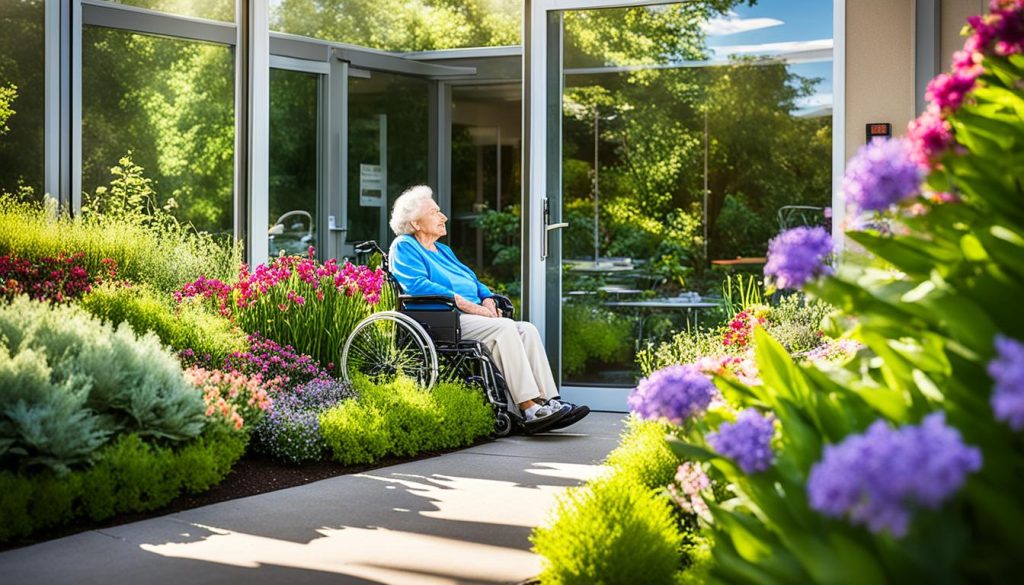As a man who spent a decade loving a woman with chronic illnesses, including endometriosis and fibromyalgia, I have gained invaluable insights into the world of long-term caregiving. Witnessing my wife’s journey and experiencing the daily challenges she faces has shaped me into the compassionate and understanding man I am today. Through this journey, I have become an advocate for caregiver support and have dedicated myself to sharing my knowledge and expertise with other men in my position.
Understanding the physical and emotional toll that chronic illnesses can have on a person is crucial for any caregiver. It requires patience, empathy, and a willingness to listen and learn. Seeing the resilience and strength my wife displays every day has inspired me to continue advocating for caregiver support and raising awareness about chronic illnesses.
Through my blog, I have found a therapeutic outlet to share my experiences and offer resources for long-term caregiving. It brings me immense joy to connect with other men who are supporting their partners through similar challenges. Together, we can navigate the complexities of caregiving and create a community where no one feels alone.
Tips to Improve Patience in Caregiving
Improving communication and managing caregiver stress are essential for cultivating patience in long-term caregiving. Here are some tips to help you navigate the challenges and maintain patience in your caregiving role:
1. Intentionally put yourself in circumstances that require patience:
By consciously seeking out situations that test your patience, you can build your capacity for patience over time. Embrace the challenges and use them as opportunities to practice patience and understanding.
2. Accept the current circumstances:
Recognize that you may not be able to control or change every aspect of the caregiving journey. Accepting the present reality can help shift your focus towards finding solutions and maintaining a positive mindset.
3. Channel your inner child:
Tap into your inner childlike curiosity and playfulness. Approach caregiving with a sense of wonder and adaptability, allowing yourself to be open to new experiences and perspectives.
4. Actively listen to the care recipient:
Take the time to truly listen and understand the needs, concerns, and desires of the person you are caring for. Practice active listening techniques such as paraphrasing and clarifying to ensure effective communication.
5. Resist the urge to immediately fix or problem-solve:
Instead of rushing to provide solutions, give the care recipient space to express themselves. Sometimes, people just need to be heard and understood. Be patient and offer support without jumping to quick fixes.
6. Focus on your breathing:
When you feel your patience wearing thin, take a moment to focus on your breath. Deep breathing exercises can help you calm your mind, reduce stress, and regain patience in the midst of challenging situations.
7. Manage caregiver stress:
Stress can significantly impact your ability to maintain patience. Prioritize self-care activities such as exercise, meditation, and taking breaks. Reach out to support groups or professional counselors who can provide guidance and assistance.
8. Develop coping strategies:
Caregiving can be emotionally and physically demanding. Find healthy coping strategies that work for you, such as journaling, practicing mindfulness, or engaging in hobbies. These strategies can help you manage stress and maintain patience in the long run.
Remember, caregiving is a journey that requires patience, understanding, and self-care. By implementing these tips, you can improve your ability to navigate the challenges of long-term caregiving and provide the best care for your loved one.

Understanding the Needs of Long-Term Care Recipients
As a caregiver, it is crucial to understand the unique needs of long-term care recipients. Each individual may have different physical, emotional, and social needs that require your attention and understanding. By taking the time to listen to their concerns, observe their behavior, and communicate openly, you can gain a deeper understanding of their needs and provide the appropriate care and support.
Listening actively is a key component of understanding the needs of long-term care recipients. By actively listening, you can not only hear what they are saying but also pick up on non-verbal cues and emotions. This will help you uncover their unexpressed needs, desires, and worries.
Observing their behavior is equally important. Pay attention to their body language, facial expressions, and interactions with others. These actions can provide valuable insights into their emotional and social needs. For example, if they seem withdrawn or less interested in social activities, it may indicate a need for companionship or engagement.
Open communication is the foundation for understanding the needs of long-term care recipients. Encourage them to express their feelings and concerns without judgment. Create a safe space where they feel comfortable sharing their thoughts and emotions. Be patient and empathetic as they may struggle to communicate their needs effectively.
When you understand the needs of long-term care recipients, you can provide them with appropriate care and support. Whether it’s assisting with daily activities, providing emotional comfort, or connecting them with resources, your understanding will help ensure their well-being and improve their quality of life.
Incorporate the Needs of Each Individual
It is essential to tailor your care approach to the specific needs of each long-term care recipient. Consider their unique requirements and preferences when creating a care plan. One individual may have physical limitations that require mobility aids and specialized exercises, while another may require emotional support and companionship. By incorporating these specific needs into your caregiving approach, you can provide personalized and effective care.
Examples of Long-Term Care Needs
- Physical needs: Assistance with mobility, medication management, and personal hygiene.
- Emotional needs: Providing a supportive and compassionate presence, validating their feelings, and offering emotional comfort.
- Social needs: Encouraging social interactions, arranging outings or virtual gatherings, and connecting them with support groups.
- Intellectual needs: Stimulating cognitive abilities through puzzles, brain exercises, and engaging conversations.
- Spiritual needs: Accommodating religious practices, facilitating spiritual conversations, and connecting them with appropriate religious or spiritual resources.
Understanding the diverse needs of long-term care recipients allows you to tailor your caregiving approach, ensuring they receive the best possible care and support. By actively listening, observing their behavior, and maintaining open communication, you can develop a deep understanding of their individual needs and provide compassionate care that promotes their overall well-being.
Building Empathy in Caregiving
Building empathy in caregiving is essential for maintaining patience and understanding. When you put yourself in the shoes of the care recipient, you gain a deeper understanding of their experiences and challenges. This empathy allows you to provide care with compassion and sensitivity, creating a more meaningful and fulfilling caregiving experience for both you and your loved one.
One way to build empathy is to actively listen to the care recipient. Truly listening involves giving your full attention, without interrupting or rushing to offer solutions. It’s about creating a safe space for them to express themselves and validating their feelings.
Another key aspect of building empathy is practicing patience. Caregiving can be stressful and demanding, but maintaining patience is crucial. Take a moment to pause, breathe, and remind yourself to approach each situation with understanding and kindness. By doing so, you create an environment of trust and support.
Practicing Empathetic Communication
In addition to active listening and patience, empathetic communication is an essential part of building empathy. Here are some strategies to enhance your communication skills:
- Use “I” statements: Expressing your thoughts and feelings using “I” statements instead of “you” statements can help avoid blame and create a more empathetic conversation.
- Show genuine interest: Ask open-ended questions and show genuine curiosity about the care recipient’s experiences and emotions. This demonstrates that you value their perspective.
- Validate their emotions: Acknowledge and validate the care recipient’s emotions without judgment. Let them know that their feelings are valid and understood.
- Practice empathy: Put yourself in their shoes and imagine how they might be feeling. This can help you respond with more empathy and understanding.
By incorporating these strategies into your caregiving routine, you can build empathy and deepen your connection with the care recipient. Building empathy not only enhances the quality of care you provide but also nurtures a stronger and more meaningful relationship.

Remember, building empathy takes time and effort. Be patient with yourself as you navigate the challenges of caregiving and continue to cultivate empathy in your caregiving journey.
Improving Communication in Caregiving
Effective communication plays a vital role in caregiving, fostering understanding and enhancing the overall caregiving experience. By utilizing key communication strategies, caregivers can develop stronger connections with their care recipients, improving their ability to meet their needs. Here are some essential tips to improve communication in caregiving:
1. Active Listening:
Active listening is the foundation of effective communication. It involves giving your full attention to the care recipient, maintaining eye contact, and actively engaging in the conversation. By listening attentively, you can better understand their thoughts, feelings, and concerns.
2. Empathy:
Empathy is the ability to understand and share the feelings of another person. By putting yourself in the care recipient’s shoes, you can gain insight into their experiences and emotions. This allows you to respond with empathy and compassion, creating a safe and supportive environment.
3. Clear and Concise Language:
When communicating with your care recipient, it’s important to use clear and concise language. Avoid jargon or complex terminology and tailor your communication style to their understanding. This helps to ensure that your message is easily comprehensible.
4. Seek Support:
Improving communication skills requires practice and support. Connect with other caregivers through support groups or online communities to share experiences and seek advice. Additionally, healthcare professionals can provide valuable guidance and resources to enhance your communication abilities.

| Benefits of Improving Communication in Caregiving | Effective Strategies |
|---|---|
| 1. Building trust and rapport | 1. Active listening |
| 2. Enhancing understanding of care recipient’s needs | 2. Empathy |
| 3. Reducing misunderstandings and conflicts | 3. Clear and concise language |
| 4. Strengthening the caregiver-care recipient relationship | 4. Seeking support from other caregivers and healthcare professionals |
Managing Caregiver Stress
As a caregiver, you are no stranger to the stress and demands that come with the role. It’s crucial to prioritize your own well-being and effectively manage your stress levels to continue providing the best care for your loved one. Here are some strategies to help you navigate and alleviate caregiver stress:
1. Self-Care Practices
Taking care of yourself is not selfish; it’s essential for maintaining your physical and mental health. Incorporate self-care practices into your routine, such as:
- Regular exercise to reduce stress and boost your mood.
- Engaging in relaxation techniques like deep breathing exercises, meditation, or yoga.
- Seeking support from friends, family, and support groups who can provide empathy and understanding.
2. Taking Breaks and Setting Boundaries
Remember that it’s okay to take breaks when you need them. Respite care can provide temporary relief, giving you time to recharge and focus on yourself. Additionally, setting boundaries and asking for help can prevent burnout and ensure that you have the energy and patience necessary for long-term caregiving.
3. Seek Professional Help and Resources
Don’t hesitate to seek professional help and utilize available resources. Connect with therapists or counselors who specialize in caregiver support. They can help you explore coping strategies, provide a safe space to express your emotions, and offer guidance on managing stress effectively.
Support groups or caregiver organizations can provide valuable resources, advice, and a sense of community. These platforms allow you to connect with others who are going through similar experiences, fostering a support network that can provide emotional relief and practical solutions.
4. Maintain Perspective and Practice Acceptance
It’s essential to maintain perspective and practice acceptance throughout your caregiving journey. Recognize that some situations may be beyond your control, and it’s okay to ask for help or seek alternative solutions. Accepting the limitations of the situation can help alleviate stress and allow you to focus on providing compassionate care.

| Signs of Caregiver Stress | Strategies for Managing Stress |
|---|---|
| Feeling overwhelmed and exhausted | Implementing self-care practices and seeking support from others |
| Irritability and mood swings | Taking breaks, setting boundaries, and practicing relaxation techniques |
| Difficulty concentrating or making decisions | Engaging in regular exercise and seeking professional help if needed |
| Physical symptoms like headaches or digestive problems | Connecting with support groups and utilizing available resources for caregiver support |
By implementing these strategies and prioritizing your well-being, you can effectively manage caregiver stress. Remember, taking care of yourself is crucial not only for your own health and happiness but also for maintaining your patience and understanding in long-term caregiving.
Coping Strategies for Long-Term Caregiving
Long-term caregiving can be emotionally and physically challenging. As a caregiver, it is crucial to implement effective coping strategies to navigate the difficulties of this role and maintain your patience and understanding. By prioritizing your well-being and seeking support when needed, you can provide the best care possible to your loved ones. Here are some coping strategies to consider:
- Seek Emotional Support: Connect with other caregivers who understand your experiences. Join support groups, online forums, or seek counseling to share your feelings, gain validation, and receive guidance.
- Practice Self-Care: Make time for activities that bring you joy and relaxation. Engage in hobbies, exercise regularly, get enough sleep, eat nutritious meals, and prioritize self-care to maintain your physical and mental well-being.
- Set Realistic Expectations: Accept that you are doing your best, and it’s not possible to be perfect. Set realistic expectations for yourself and your loved ones, understanding the limits of your capabilities.
- Seek Professional Help: Don’t hesitate to reach out to healthcare professionals and specialists who can provide guidance and support. They can offer valuable advice, resources, and assistance tailored to your specific caregiving situation.
Remember, taking care of yourself is not selfish. It is necessary to maintain your well-being and continue providing quality care. By implementing these coping strategies, you can navigate the challenges of long-term caregiving with resilience, patience, and compassion.
The New Normal with Chronic Illness: Lifestyle and Adaptations
Living with a chronic illness can bring about significant changes in daily life. As a caregiver, it is crucial to adapt to these changes and support the care recipient in establishing a new normal. This entails making adjustments to daily routines, seeking support from healthcare professionals, and finding ways to maintain a harmonious life despite the challenges posed by chronic illness.
Adapting to the new normal requires patience and understanding. The care recipient may experience physical limitations, emotional fluctuations, and lifestyle modifications. By empathizing with their struggles and actively listening to their concerns, you can provide the support they need to navigate this journey.
One effective way to adapt is by making adjustments to daily routines. This can involve incorporating medications, therapies, or treatments into the care recipient’s schedule. It may also require modifying the living environment to accommodate any mobility or accessibility needs. By ensuring that the care recipient’s daily routine is structured and tailored to their specific requirements, you can facilitate a sense of stability and control.
Seeking support from healthcare professionals is also essential in navigating the new normal. Collaborating with doctors, therapists, or support groups can provide invaluable guidance and resources. These professionals can offer advice on medication management, pain management techniques, and coping strategies, enabling both the caregiver and care recipient to better cope with the challenges of chronic illness.
Furthermore, maintaining a holistic and balanced lifestyle is crucial in adapting to the new normal. Encouraging the care recipient to engage in activities they enjoy, maintaining a nutritious diet, and promoting regular exercise can contribute to their overall well-being. It is also important to prioritize self-care as a caregiver, ensuring you have the physical and emotional energy to support your loved one.
Managing the impact of chronic illness on daily life requires patience, understanding, and resilience. It is an ongoing journey of adaptations and modifications, but with dedication and perseverance, you can help the care recipient continue to thrive despite the challenges they face.
Lifestyle and Adaptations in Chronic Illness
| Lifestyle | Adaptations |
|---|---|
| Daily Routine | Adjustments to accommodate medications, therapies, and mobility needs |
| Support | Collaboration with healthcare professionals, support groups, and therapists |
| Physical Well-being | Engagement in enjoyable activities, maintaining a nutritious diet, regular exercise |
| Self-Care | Prioritizing physical and emotional well-being as a caregiver |
Loving a Woman with a Chronic Illness
When you care for a woman with chronic illnesses like endometriosis and fibromyalgia, your love and support can make a world of difference. It requires patience, understanding, and empathy to navigate the challenges she faces on a daily basis. One of the most important things you can do as a caregiver is to acknowledge and validate her experiences. Let her know that you see her struggles and that her feelings are valid.
Actively listening to her needs is crucial for providing the support she requires. Take the time to truly hear her, without judgment or the need to offer quick fixes. Sometimes, all she needs is a listening ear and a shoulder to lean on. By actively listening, you can better understand her unique challenges and be there for her in the ways that she needs.
Caring for a woman with chronic illnesses may require adapting to lifestyle changes. It is important to be flexible and supportive as she finds new ways to navigate her daily life. Encourage her to seek out resources and support groups that can provide valuable information and a sense of community. Together, you can find ways to maintain a loving and supportive relationship, even in the face of chronic illness.
